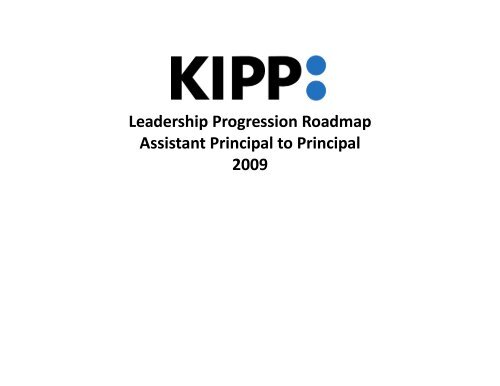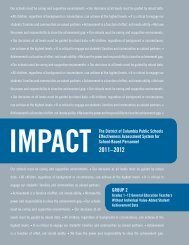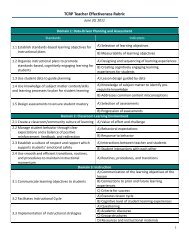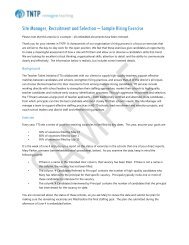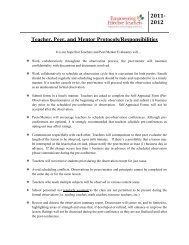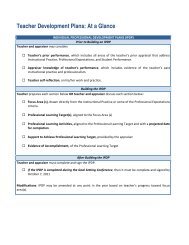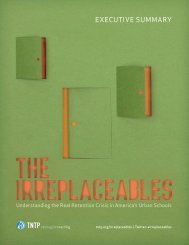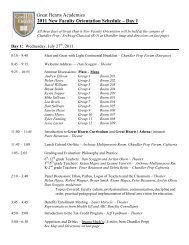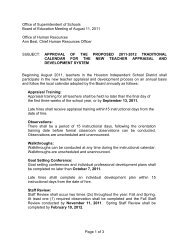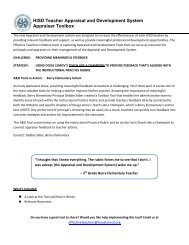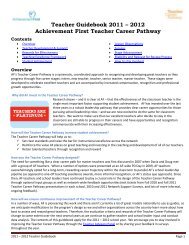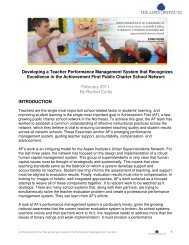Leadership Progression Roadmap Assistant Principal to ... - TNTP
Leadership Progression Roadmap Assistant Principal to ... - TNTP
Leadership Progression Roadmap Assistant Principal to ... - TNTP
Create successful ePaper yourself
Turn your PDF publications into a flip-book with our unique Google optimized e-Paper software.
<strong>Leadership</strong> <strong>Progression</strong> <strong>Roadmap</strong><strong>Assistant</strong> <strong>Principal</strong> <strong>to</strong> <strong>Principal</strong>2009
IntroductionThe <strong>Leadership</strong> <strong>Progression</strong> <strong>Roadmap</strong> is a <strong>to</strong>ol for aspiring andcurrent KIPP leaders <strong>to</strong> better understand what <strong>to</strong> expect whentransitioning from one role <strong>to</strong> the next. Rather than a simpledescription of the new job, this <strong>Roadmap</strong> details the specificchanges you will experience in your transition <strong>to</strong> a newleadership role. These changes, or “shifts,” will impact whatskills you must cultivate, how you spend your time at work, aswell as what you focus on in order <strong>to</strong> be successful in your role.Mastery of a new leadership position at KIPP will require you <strong>to</strong>successfully navigate these shifts.<strong>Leadership</strong> Competency ModelFor teachers and leaders considering new roles, this <strong>Roadmap</strong><strong>to</strong>ol gives you information you need <strong>to</strong> make an informeddecision about taking on a more advanced leadership rolewithin KIPP, and will help you prepare <strong>to</strong> make shifts. Formanagers, this will be a helpful <strong>to</strong>ol both in determining whichmembers of your team may be ready <strong>to</strong> take on new challengesand for coaching leaders <strong>to</strong>wards readiness. The Realistic JobPreview <strong>to</strong>ol supports this <strong>Roadmap</strong>, and will add <strong>to</strong> yourunderstanding of the leadership position you may beconsidering.1
What changes? The Big PictureAs the leader and face of the school, the<strong>Principal</strong> will not only set a high standard forachievement, but will serve as a role modelfor results orientation and continuouslearning. S/he will take a broad view whenplanning and prioritizing, realizing that his/herdecisions will impact all students, teachersand likely others. The <strong>Principal</strong> must beprepared <strong>to</strong> take fast and decisive action asissues arise at school, often with minimalinformation and time <strong>to</strong> analyze. S/he mustalso be adept at delegating certain decisions<strong>to</strong> members of the leadership team, such asAPs and GLCs.The <strong>Principal</strong> is the point person for setting theschool’s direction and inspiring others <strong>to</strong>embrace the school culture. As a manager ofmanagers, s/he must delegate effectively, andempower the Asst. <strong>Principal</strong>s and/or GLC’s <strong>to</strong>lead their own teams. The <strong>Principal</strong> owns theschool’s performance management process.S/he ensures that teachers and staff establishperformance goals, and provides regularfeedback on progress. Organizationally, the<strong>Principal</strong> ensures that the right employees areselected, promoted and retained.<strong>Principal</strong>s work with an even larger number ofstakeholders, now including some outside theschool. As a result, the <strong>Principal</strong> must beeffective at communicating <strong>to</strong> many differentaudiences, requiring greater self‐awarenessand sensitivity <strong>to</strong> his/her <strong>to</strong>ne and style. S/hewill use both direct and indirect influenceapproaches, and will need <strong>to</strong> build a presenceand establish trust with the local communityserved by the school.For many, the shift <strong>to</strong> <strong>Principal</strong> is their firstexperience with active operationalmanagement. The <strong>Principal</strong> owns budgetaryplanning and decision making for the school.Though the <strong>to</strong>tal scope of a <strong>Principal</strong>’sbusiness management responsibility will varyby region, every KIPP <strong>Principal</strong> must balancetime and attention between trackingacademic progress and moni<strong>to</strong>ring schoolbusiness operations.2
Competency shifts: Which competencies change the most?AchievementOrientationCommunicationDirectionSettingTalentDevelopment: You now set the performance standard that the entire school is expected <strong>to</strong> achieve: You must demonstrate follow through on commitments made <strong>to</strong> more stakeholders than ever: You demonstrate resilience in confronting an extraordinary number of daily challenges in your school: You now speak as the voice of the school <strong>to</strong> the greater community: You communicate through others <strong>to</strong> spread your message within and beyond the school: More of your communication is formal, and presented <strong>to</strong> larger groups: All school‐wide goals and objectives now originate with you or have your endorsement: You must inspire many more people <strong>to</strong> carry your leadership message forward <strong>to</strong> several diverse audiences: You are expected <strong>to</strong> lead by example, being a role model for desired school culture, behavior and values: You now manage the processes for selection and development of all school employees: You provide just‐in‐time resources and opportunities for the development of those employees, and cultivateleadership within your schoolOperationalManagement: You are responsible for retaining <strong>to</strong>p talent, as well as managing out poor performers when required: School financial planning and management are now your responsibility: You are accountable <strong>to</strong> the ED and/or Board for making prudent decisions regarding the school’s management: You are expected <strong>to</strong> partner with regional leadership and/or the Board <strong>to</strong> acquire necessary additional resourcesfor the operation of the school* Refer <strong>to</strong> the KIPP <strong>Leadership</strong> Competency Model, Proficiency <strong>Roadmap</strong> and Job Preview for detailed explanations of these competencies3
Time shifts: The changes in your daily workServing a key role on the schoolleadership teamResolving academic and/or studentdiscipline issuesEnforcing achievement ofacademic goalsPromoting and supporting theschool cultureStaying aware of businessoperationsResolving tactical issues that ariseduring the school dayConsiderable time spent observingand coaching teachersActing as the face and voice of theentire schoolOverseeing all aspects of studentachievement and schooloperationsSetting academic goals and drivingschool‐wide achievementEnsuring that school environment,activities, and student and staffbehavior are aligned with schoolvaluesMaking budget, staffing andbusiness operations decisionsDelegating issue resolution <strong>to</strong> APsand GLCs as appropriateReduced time in the classroomand coaching teachers4
<strong>Leadership</strong> Proficiency <strong>Roadmap</strong><strong>Principal</strong>s2009
Background<strong>Leadership</strong> Competency ModelThe Proficiency <strong>Roadmap</strong> is a reference <strong>to</strong>ol forKIPP <strong>Principal</strong>s and those who coach, develop,and evaluate them. This <strong>to</strong>ol can be used <strong>to</strong>help principals think about specific behaviorsthat will help them <strong>to</strong> grow as KIPP leaders.Following the receipt of a 360 feedback surveyor an evaluation, principals can refer <strong>to</strong> thiscompetency‐based roadmap <strong>to</strong> reflect uponhow <strong>to</strong> improve upon specific strengths orfurther develop in specific priority areas forgrowth. Similarly, those who coach, developand evaluate KIPP <strong>Principal</strong>s can use this <strong>to</strong>ol asa reference for pointing out specific behaviorsthat will help principals grow as leaders. Finally,this <strong>to</strong>ol can help Executive Direc<strong>to</strong>rs andBoards evaluating principals <strong>to</strong> think abouttheir level of proficiency for each of the keybehaviors. This <strong>to</strong>ol should be used as areference for considering specific areas ofgrowth; it is not expected that users will reviewthis entire document in one sitting. Tosupplement this <strong>to</strong>ol, please refer <strong>to</strong> theRealistic Job Preview for <strong>Principal</strong>s, which offersvery specific, day‐<strong>to</strong>‐day examples of each keybehavior, either at the proficient or masterlevel.1
Proficiency LevelsThe three levels of proficiency refer <strong>to</strong> the skill level and expertise of the leader, but not their experience or tenure in the position.It is important <strong>to</strong> note that it is virtually impossible for a leader <strong>to</strong> be at the “Master” level on all behaviors. Thus, when using thisroadmap each behavior should be seen as completely independent of the others. Someone could easily be at the “Master” level onone or more behaviors and at the “Novice” level on many others. Note that if someone is at the “Proficient” or “Master” level for aparticular behavior, it can be assumed that they are effectively performing the behaviors of the lower levels (e.g., an individual atthe “Master” level of a behavior is effectively performing the “Novice” and “Proficient” levels of that behavior as well).The proficiency levels are written using the following general guidelines:Novice:Leaders at this level are performing the basicbehaviors required for the job, but at a minimallyacceptable level. Leaders at this level can beconsidered <strong>to</strong> be in a learning mode for thisparticular behavior. Frequently, this level ofbehavior involves responding <strong>to</strong> circumstancesrather than being proactive. Leaders at this levelalso tend <strong>to</strong> see issues from the standpoint of asmall set of constituents rather than seeingissues broadly with a more organizational focus.Leaders who have many behaviors in thiscategory may get results, but often do so withconsiderable assistance from their directmanager and must expend considerable effortlearning and developing skills.Proficient:This level describes a leader who is performingeffectively on a behavior <strong>to</strong> achieve results forthe organization. Often, these behaviors addressorganizational needs proactively and involveconsideration of long‐term consequences.Generally, someone at this level of behavior willdrive results for the organization and thereshould be no pressing need <strong>to</strong> improve in thisarea for the organization <strong>to</strong> succeed.Master:The master level of behavior implies a significantstep up from the proficient level. Leaders at thislevel are seen by others as experts, models andaccomplished. At this level of behavior, leaderstend <strong>to</strong> focus on long‐term sustainability bymen<strong>to</strong>ring others and empowering individuals sothat results are achieved by others rather thanthrough the direct effort of the leader. This levelof behavior goes above and beyond what would beexpected normally of a leader, but it is where trulyexceptional organizational results are seen. Aleader who consistently achieves at this level inmany behaviors will likely have a highly functioningteam that can get exceptional results with minimaldirect involvement by the leader. These leaderstend <strong>to</strong> produce exceptional talent and havepotential for advancement themselves.2
STUDENT FOCUSHigh ExpectationsStudent BestInterestsCommitmentsRespectRelationshipsNovice Proficient MasterHolds the leadership team and other staffaccountable for consistently demonstratinghigh expectations for students on a daily basis.Ensures that every aspect of the schoolsupports student’s pursuit of college and selfsufficiency after graduation.Expresses high expectations for all studentsand expresses belief in their potential <strong>to</strong>complete college and succeed in life.Demonstrates passion for students and anauthentic desire for students <strong>to</strong> succeed butmay make some decisions without fullyunderstanding the needs and motivations ofstudents or circumstances behind their actions.Makes following through on commitments <strong>to</strong>students a priority.Respects students in actions and words.Acts as a trusted advisor <strong>to</strong> students, teachersand staff when they seek out assistance.Seeks <strong>to</strong> understand the needs andmotivations of students and makes decisionswith students’ best interests and needs inmind. Holds entire school staff accountable <strong>to</strong>do the same.Keeps all commitments made <strong>to</strong> students andholds others accountable <strong>to</strong> do the same.Willing <strong>to</strong> reverse decisions when doing so isnecessary <strong>to</strong> keep commitments made <strong>to</strong>students.Establishes and maintains a culture of respectby communicating expectations that allstudents should be treated with respect andholding staff accountable for maintainingrespect for students.Establishes and maintains strong relationshipswith students. Encourages and works closelywith teachers and staff <strong>to</strong> help them do thesame.Personally men<strong>to</strong>rs students with an emphasison setting and achieving high‐level goals.Works with parents <strong>to</strong> increase theirconfidence in their student’s ability <strong>to</strong> succeed.Consistently uses both data and intuition <strong>to</strong>make decisions in the best interest of students.Coaches teachers, the <strong>Leadership</strong> Team, andother staff <strong>to</strong> ensure that they consider theneeds and motivations of students whenmaking decisions.Men<strong>to</strong>rs school’s <strong>Leadership</strong> Team andteachers <strong>to</strong> ensure that they make realisticcommitments <strong>to</strong> students and ensure followthrough.Immediately responds with direct timelyfeedback when teachers or students addressstudents disrespectfully. Treats thesesituations as “teachable moments” for bothparties <strong>to</strong> support a school‐wide culture ofrespect. Also ensures that teachers andstudents treat each other with respect.Leverages relationships and connects studentsand staff with one another <strong>to</strong> enhance theachievement of results.PRINCIPALS 3
ACHIEVEMENT ORIENTATIONChallenging GoalsInitiativeFollow ThroughResilienceFlexibilityFocus on ResultsNovice Proficient MasterDemonstrates high expectations by settingchallenging goals for self, teachers, studentsand staff. Models excellence for others bysetting goals high and working hard <strong>to</strong> achieveresults.Strives for success by putting in extra effort <strong>to</strong>achieve results.Takes initiative, going above and beyondtypical expectations <strong>to</strong> achieve results.Strives <strong>to</strong> achieve commitments <strong>to</strong> students,parents and teachers but may not always betimely with responses or delivery.Overcomes obstacles effectively by expendingextra effort when needed and seeking creativesolutions <strong>to</strong> problems.Reacts <strong>to</strong> the unexpected by shifting resourcesand personally addressing issues.Encourages staff, teachers and students <strong>to</strong>work hard by expressing the importance ofachieving results.Encourages, supports and holds leadershipteam and staff accountable for taking initiativeand going beyond typical expectations.Follows through on commitments andpromises with an appropriate sense ofurgency. Includes commitments <strong>to</strong> parents,teachers, students and staff, as well as externalstakeholders.Demonstrates tenacity, persevering throughsignificant challenges <strong>to</strong> reach long and shortterm goals. Supports perseverance in teachers,students and staff <strong>to</strong> achieve goals.Demonstrates flexibility and easily adaptswhen plans or situations change unexpectedly.Effectively adjusts plans (including goals,timelines, etc.) <strong>to</strong> achieve intended outcomes.Focuses upon results and how they areachieved especially in terms of ensuringteacher and student successes. Does notconfuse effort with results.Collaborates with teachers and staff <strong>to</strong> setchallenging goals for themselves and students.Consistently challenges students <strong>to</strong> set theirown standards high.Role models “initiative” by making personalsacrifices and taking responsibility for makingsure results are achieved.Consistently prioritizes and follows through onall commitments regardless of who thecommitment was made <strong>to</strong>. Ensures thatleadership team members hold teachers, staffand students accountable for theircommitments in an effort <strong>to</strong> establish a culturethroughout the school that promises are kept.Integrates learning from overcoming pas<strong>to</strong>bstacles and creates policies or processes sothat others who encounter similar challengeswill find it easier <strong>to</strong> successfully overcome thesame challenges.Plans for contingencies so when suddenchanges occur, resources are available <strong>to</strong>respond effectively without diverting all ofhis/her focus <strong>to</strong> managing the change. Helpsstaff, teachers, students and parents adjust <strong>to</strong>changes and see plans as flexible.Holds the <strong>Leadership</strong> Team, school staff andteachers accountable for achieving specificoutcomes while actively coaching them ontheir approach. Holds others accountable forresults and how they achieve them.PRINCIPALS 4
CONTINUOUS LEARNINGLearningRisk TakingData‐basedImprovementsResearchImprovementInnovationSharingNovice Proficient MasterTakes responsibility for his/her own behavior,mistakes and results. Learns from successesand failures.Focuses primarily on failures, shortcomings ormistakes <strong>to</strong> improve results.Manages risk by minimizing it. When risks aretaken, may not always calculate theadvantages and disadvantages.Experiments with new ideas on the basis ofrecommendations from others.Uses personal experience and the experienceof others <strong>to</strong> inform decision‐making.Manages the status quo while exploring a fewopportunities for personal and organizationalimprovement.Listens <strong>to</strong> the ED, parents, staff, teachers andstudents when they offer suggestions forinnovations.Willingly shares information about currentschool practices <strong>to</strong> those who ask. Activelyparticipates in dialogues with teachers andstaff about best practices.Takes calculated risks by weighing thepotential reward against consequences offailure.Uses data from a wide range of sources <strong>to</strong>accurately assess areas for improvement inevery aspect of the school’s curriculum,teaching, culture, and operations.Uses research on best practices <strong>to</strong> inform thedevelopment of policies, procedures andcurriculum. Shares current research withteachers regularly.Continuously and humbly seeks opportunitiesfor personal and organizational improvement.Proactively solicits and willingly acceptsassistance.Values and actively encourages creative andinnovative ideas offered by the ED, students,parents, teachers and external stakeholders.Promotes and actively encourages sharingeffective practices throughout the schoolcommunity and across the KIPP network.Treats every success and failure as a learningopportunity and actively engages others inlearning from their own behavior by acting as arole model. Reflects on own behavior andmakes improvements even when others aresatisfied.Proactively seeks new opportunities and thenassesses risk and rewards before pursuingthem. Helps <strong>Leadership</strong> Team, staff andteachers see risks as opportunities. Does postmortemassessment of risk <strong>to</strong> understand itsimpact on future decisionsTeaches <strong>Leadership</strong> Team, staff and teachers<strong>to</strong> use qualitative and quantitative data <strong>to</strong>assess the needed improvements inoperations, teaching and student achievement.Whenever possible, identifies a research base(either existing or via pilot research) <strong>to</strong> supportnew programs and initiatives. Assureseffectiveness of programs beforeinstitutionalizing them. Actively solicits <strong>to</strong>picalexperts from within and outside the KIPPcommunity <strong>to</strong> learn best practices.Holds self, <strong>Leadership</strong> Team, staff and teachersaccountable for personal and organizationalimprovements. Actively men<strong>to</strong>rs teachers andstaff <strong>to</strong> achieve improvements. Effectivelyprioritizes improvements.Proactively seeks out opportunities <strong>to</strong>experiment with creative and innovative ideas.Coaches others <strong>to</strong> do the same. Testsinnovations <strong>to</strong> determine whether broaderimplementation is warranted.Regularly and publicly shares effectiveeducational and policy methods. Createsopportunities for staff and teachers <strong>to</strong>regularly share best practices for the purposeof improving others (e.g., presents at KIPPSummit or other conferences). Shares insightsamong teachers, parents, other schools, andwithin the field of education.PRINCIPALS 5
CRITICAL THINKING AND PROBLEM SOLVINGGatheringInformationSorting OutComplexityAnticipatingProblemsBreaking DownInformationAnalysisWeighing OptionsNovice Proficient MasterWhen problem solving, gathers informationfrom multiple relevant sources andstakeholders, including those both internal andexternal <strong>to</strong> the school.Problem solves alone or with input from one ortwo trusted colleagues.Considers all of the relevant data when makingdecisions.Identifies problems and strives <strong>to</strong> findsolutions.Sets aside large amounts of time and resources<strong>to</strong> analyze complex problems.Focuses primarily on solving a problempromptly and may only look at obvious factsand not take the time <strong>to</strong> analyze andsynthesize the information in‐depth.Examines the pros and cons of a conclusionwhen problem solving.Identifies useful relationships among complexdata from unrelated areas.Anticipates and identifies problems promptlyso they can be addressed in a timely fashion.Solves complex problems by breakinginformation and problems in<strong>to</strong> parts.Analyzes, synthesizes, and contextualizesinformation; allowing adequate time <strong>to</strong> reflec<strong>to</strong>n sufficient data <strong>to</strong> amass before coming <strong>to</strong> aconclusion. Seeks out information that may notbe apparent on the surface.Weighs pros and cons of multiple options <strong>to</strong>solve complex problems.Problem solves using a collaborative processwith involvement from the key stakeholderswhen appropriate. Makes sure <strong>to</strong> involveleadership team members or other staff in keydecisions. Effectively men<strong>to</strong>rs leadership teammembers on how <strong>to</strong> involve others whenproblem solving.Proactively seeks out potentially conflictingdata in order <strong>to</strong> sort out the complexity andarrive at new ways of addressing problems.Effectively re‐positions data with audiences <strong>to</strong>illustrate important relationships that supportconclusions.Proactively identifies issues before theybecome a problem. Delegates problems <strong>to</strong>leadership team members, teachers and staffwho are in the right position <strong>to</strong> create the bestsolutions.Coaches the leadership team, teachers, staffand students on how <strong>to</strong> break down complexinformation and problems in<strong>to</strong> parts.Questions leadership team members, teachers,staff and others about their analyses andconclusions by probing in<strong>to</strong> issues that may notbe immediately apparent. Coaches staff <strong>to</strong>analyze, reflect upon, synthesize, andcontextualize information.Seeks others’ input regarding the pros andcons of various alternatives when problemsolving. Coaches and expects the <strong>Leadership</strong>Team, staff, teachers and students <strong>to</strong> presentcogent analyses that consider pros and conswhen considering alternative courses of action.PRINCIPALS 6
DECISION‐MAKINGProcessesConsequencesSense of UrgencyCommunicatingDifficult ChoicesNovice Proficient MasterEstablishes clear decision making processes,communicating proactively about howdecisions will be made and who has input andensuring that decisions are made by individualsbest suited <strong>to</strong> make them.Communicates clearly about how decisionshave been made and uses transparentmethods for making decisions. Prefers <strong>to</strong>pdowndecision making. May not always usecollaborative decision making appropriately.Makes decisions that effectively address theimmediate needs of students, parents,teachers and staff.Focuses primarily on making the “best”possible decision and thus decisions may notalways be made on a timely basis.Explains decisions <strong>to</strong> staff, teachers, parents,the ED, and students when asked, but may notproactively reach out <strong>to</strong> stakeholder groups.Seeks alternatives before making difficultdecisions so that “no s<strong>to</strong>ne is left unturned”.Considers both the longer‐term andunintended consequences of potentialdecisions on the entire school community.Makes the right decision in a timely manner,using intuition, as well as data in the face ofambiguity.Timely and effectively conveys decisions <strong>to</strong>students, teachers, staff, the ED, and parentsand takes follow‐up actions <strong>to</strong> supportdecisions.Promptly makes and stands by controversialdecisions that benefit the organization. Sharesthe rationale for decisions with the <strong>Leadership</strong>Team, students, parents, teachers and staff,particularly when consensus cannot bereached.Effectively uses <strong>to</strong>p‐down decision making ORmore consensus‐based methods depending oncircumstances. Regularly solicits input from keystakeholders (including the ED, the <strong>Leadership</strong>Team, parents, teachers and students)regarding decision‐making processes.Effectively balances the short and long termconsequences of any decision. Helps the<strong>Leadership</strong> Team, teachers and staff see thelong‐ and short‐term implications of theirdecisions.Effectively balances time demands withconcerns for the quality and accuracy ofdecisions. Coaches <strong>Leadership</strong> Team members<strong>to</strong> avoid “analysis paralysis” when makingdecisions.Develops standardized procedures (often viathe <strong>Leadership</strong> Team) <strong>to</strong> ensure that alldecisions are communicated in a timely fashion<strong>to</strong> teachers, parents, students, the ED, andstaff using the most efficient and effectivecommunication methods.Anticipates when decisions might be difficultfor parents, students, teachers or staff <strong>to</strong>accept. Provides early warnings, significantinformation and demonstrates empathy andunderstanding when stakeholders have troubleaccepting a decision.PRINCIPALS 7
PLANNING AND EXECUTIONBackward PlanningResourcesPrioritizingAccountabilityContingency PlansNovice Proficient MasterMethodically backwards plans <strong>to</strong> achieveshort‐ and long‐term goals for the entireschool, teachers, students and staff. Ensuresthat logistics and details are thoroughlyconsidered when planning.Makes plans that effectively address shorttermgoals but may not see long‐termconsequences.Creates an annual plan that includes resourcesfor projects that balance the needs of variousteachers and staff.Manages time and resources by responding <strong>to</strong>requests as they come up and based onimmediate needs.Assesses progress during projects andinitiatives but may not have a clear sense ofhow much mid‐stream progress is needed inorder <strong>to</strong> meet the final deadline. Regularlymeets deadlines but may do so by putting inextra effort at the end <strong>to</strong> catch up.Tends <strong>to</strong> focus on identifying the “best”solution and works extremely hard <strong>to</strong> achieveit, but rarely identifies a secondary option untilthe first choice clearly will not succeed.Accurately scopes and secures resourcesneeded <strong>to</strong> accomplish the school’s goals, aswell as projects and initiatives as, requested byteachers, grade level chairs, parents andstudents.Manages his or her time and the school’sresources effectively by prioritizing effortsaccording <strong>to</strong> school‐wide and personal goals.Establishes clear and realistic miles<strong>to</strong>nes <strong>to</strong>achieve outcomes. Regularly compares actualprogress <strong>to</strong> planned miles<strong>to</strong>nes and adjustsplans accordingly. Holds self, staff, andteachers accountable for achieving miles<strong>to</strong>nes,as well as intended outcomes.Actively communicates <strong>to</strong> all stakeholders theimportance of the primary goal, but alsoproactively develops contingency plans inadvance of potential or unforeseencircumstances.Coaches the <strong>Leadership</strong> Team on how <strong>to</strong> “planahead by planning backward” (e.g., budgets,project calendars, teaching strategies, resourceallocation).Finds creative ways <strong>to</strong> provide resources whenunanticipated requests are made by<strong>Leadership</strong> Team members and teachers.Empowers and supports teachers, staff, andstudents as appropriate <strong>to</strong> secure resources <strong>to</strong>accomplish special projects.Uses short‐ and long‐term priorities for theschool <strong>to</strong> plan events and set goals. Coaches<strong>Leadership</strong> Team members, teachers and staffon how <strong>to</strong> manage their own time according <strong>to</strong>priorities and goals.Regularly communicates <strong>to</strong> team members(typically <strong>Leadership</strong> Team, staff and teachers)regarding progress <strong>to</strong>ward goals at keymiles<strong>to</strong>nes and coaches them on how <strong>to</strong> adjusttheir efforts in order <strong>to</strong> assure on‐timecompletion.Coaches the leadership team, staff andteachers on the importance of developingcontingency plans and on how <strong>to</strong> developthem. Empathetically points out potentialpitfalls and risks so others can learn <strong>to</strong>anticipate the unexpected.PRINCIPALS 8
STAKEHOLDER MANAGEMENTNetworkingDevelopingRelationshipsTrustRespect &AppreciationNovice Proficient MasterSeeks opportunities <strong>to</strong> work with a wide rangeof individuals and organizations such asteachers, parents, community groups, the ED,the regional Shared Services Team, other KIPPprincipals, local politicians and Board members<strong>to</strong> achieve common goals and betteroutcomes.stakeholders.Works regularly with internal stakeholdergroups such as teachers and staff. Responds <strong>to</strong>requests as needed but may not proactivelyestablish relationships.Develops relationships with students, parents,staff, teachers, and other stakeholders but not<strong>to</strong> the extent of planfully building trust oractively seeking out common goals.Establishes trust of those with whom s/heworks most closely. Listens <strong>to</strong> others but maynot internalize their views, thus does notalways address their concerns.Thanks people personally, but may not expressgratitude publicly. Sometimes forgets <strong>to</strong>acknowledge important contributions ofothers.Develops mutually beneficial relationships withstaff, teachers, parents, the ED, Boardmembers, community members, other KIPP<strong>Principal</strong>s, the regional Shared Services Team,and others based on trust, respect and theachievement of common goals.Gains the trust of key stakeholders, such asleadership team members, teachers, parents,community members, the ED, and boardmembers by active listening and seeking <strong>to</strong>understand their views and needs. Maintainsconfidences and follows through withcommitments.Consistently demonstrates respect andappreciation for others by empathizing withtheir concerns and valuing their time andcontributions. Publicly and privatelyacknowledges students, staff, parents andteachers for their contributions.Maintains ongoing relationships with all keyexternal stakeholders including meeting witheach on a regularly scheduled basis <strong>to</strong> createnew opportunities and connections for theschool and <strong>to</strong> further KIPP’s mission.Encourages all staff <strong>to</strong> network with keyLeverages strong relationships for mutual gainby connecting personal network members withone another <strong>to</strong> expand opportunities <strong>to</strong> exceedgoals. Continually deepens existingrelationships by relating <strong>to</strong> people on apersonal and professional level.Gains credibility by trusting others. Anticipatesthe needs of key stakeholders (including thecommunity, parents, staff, teachers, andstudents) and proactively seeks out their inputand involvement on issues as appropriate.Coaches the <strong>Leadership</strong> Team on how <strong>to</strong> buildtrusting relationships.Demonstrates outstanding timing andsensitivity with regard <strong>to</strong> publicly expressingappreciation and thanks <strong>to</strong> sponsors, parents,teachers, and staff who make importantcontributions (including promptly applaudingthose who may not have previouslycontributed, but have just recently begun <strong>to</strong> doso). Coaches members of the <strong>Leadership</strong> Teamon demonstrating respect and appreciation <strong>to</strong>foster a broad culture of respect at the school.PRINCIPALS 9
COMMUNICATIONListeningSystemsWritingSpeakingNovice Proficient MasterListens attentively <strong>to</strong> key stakeholders such as:parents, teachers, students, and communityrepresentatives. Seeks <strong>to</strong> understand others’point of view and confirms understanding.Listens <strong>to</strong> others but may not internalize theirmessage or perspective. Tends <strong>to</strong> share ownideas first before hearing others. Willing <strong>to</strong>meet with and listen <strong>to</strong> all stakeholders (e.g.maintains an open door policy) but may havefavorites whose messages are heard morereadily.Communicates using his/her own preferredmethods but may not consider the mostappropriate method (phone, written, etc.) andfor the preferences of others.Written communications are factually correct,appropriate length, and use appropriategrammar but they may omit criticalinformation, contain extraneous information,be poorly formatted or not addressstakeholder concerns.Speaks effectively with small and midsizegroups, particularly with students, parents andteachers. May not adapt content and/or style<strong>to</strong> the audience or venue.Establishes and regularly uses communicationsystems that effectively and proactively engagekey stakeholders within the school such asteachers, parents, students and staff.Effectively communicates using a varietychannels, such as one‐on‐one, group, email,memo, etc.Writes clearly, concisely and persuasively(most frequently <strong>to</strong> teachers and supportstaff). Uses a <strong>to</strong>ne and vocabulary that isappropriate <strong>to</strong> the message and audience.Speaks in a clear and articulate manner,adapting communication content and style <strong>to</strong>different audiences and venues (e.g. mediainterviews, Board meetings, or at an all‐schoolmeeting or in the homes of students).Listens <strong>to</strong> all stakeholders openly withempathy and does not hesitate <strong>to</strong> ask forclarification if uncertain of meaning or if thereare apparent contradictions in the message.Listens specifically for the fit or misfit betweenthe individual’s message and the viewpoints ofothers.Creates systems for regular communicationappropriate <strong>to</strong> internal groups such as parents,students, teachers and staff as well as externalgroups such as board members, communitymembers and the media. Effectively diagnosescommunication gaps within the school andbetween the school and outside groups andquickly resolves them. Effectively uses the<strong>Leadership</strong> Team members <strong>to</strong> cascadeinformation throughout the school.Written communications convey complexinformation using simple terms in anorganized, efficient, and compelling manner.Speaks in a compelling and articulate manner<strong>to</strong> large and small groups and ensures that themessage is clearly unders<strong>to</strong>od by the audience.Quickly and easily adjusts the content and styleof delivering a message when audience seems<strong>to</strong> be confused, or disengaged.PRINCIPALS 10
IMPACT AND INFLUENCEAdapting StyleMaking a CaseAnticipating &PersuadingMotivating ActionBuilding CoalitionsNovice Proficient MasterTo assure maximum impact on the audience,adapts personal leadership style/approachgiven the situation and the individualsinvolved.Uses a personal leadership style that is familiarand comfortable <strong>to</strong> relate <strong>to</strong> others. Has atendency <strong>to</strong> influence others by using thisfamiliar style rather than adapting the strategy<strong>to</strong> the needs of a particular audience orsetting.Effectively uses data <strong>to</strong> make a compelling casebased on a clear rationale. Tends <strong>to</strong> focus ondata and criteria aligned with own goals butmay not consider other’s needs.Persuades staff, parents and teachers byasserting expertise on a <strong>to</strong>pic or referencingjob title/position. Tends <strong>to</strong> rely on position/jobtitle when persuading staff and teachers.Effectively motivates others <strong>to</strong> take action, buttends <strong>to</strong> overcome resistance by relying onformal authority.Responds <strong>to</strong> emerging issues by gathering asmall group of supporters only (usually eitherparents, staff or teachers) <strong>to</strong> determine needs.Appeals <strong>to</strong> emotions and/or reason using data,concrete examples, and demonstrations <strong>to</strong>make compelling case for a position whentalking with teachers, students, parents ,staff,the ED, local politicians and the media. Usesinfluence in this manner <strong>to</strong> recruit studentsand teachers and bring other resources <strong>to</strong> theschool.Anticipates reactions and addresses concernsof staff, teachers, parents, students, thedistrict, and ED, and other local KIPP principals<strong>to</strong> help persuade them <strong>to</strong> move <strong>to</strong>ward a goalor support an idea.Motivates others <strong>to</strong> take action by expressingenthusiasm, optimism, and passion for ideasand initiatives. Effectively motivates parents,volunteers, funders, and communitysupporters even though no formal reportingrelationship exists.Builds coalitions <strong>to</strong> garner support forinitiatives or programs by aligningproposals/ideas with the needs and prioritiesof others. Focuses significant effort on buildinga strong core of involved parents.Adapts personal leadership style thoughtfully<strong>to</strong> motivate, influence and persuade others.Considers his<strong>to</strong>rical, situational, and individualcircumstances when adapting style. Seeks outteachable moments <strong>to</strong> coach leadership teammembers on how <strong>to</strong> adapt their work style <strong>to</strong>influence others more effectively.Expertly blends relevant data, concreteexamples, and demonstrations <strong>to</strong> makecompelling case for a position. Coaches the<strong>Leadership</strong> Team on how <strong>to</strong> persuade othersbased on their motivations and needs.Influences staff, teachers, parents, the ED, andother <strong>Principal</strong>s by presenting information in atimely fashion that will appeal <strong>to</strong> their interestsor views on a subject. Coaches <strong>Leadership</strong>Team members <strong>to</strong> anticipate the concerns ofothers and persuade them <strong>to</strong> move <strong>to</strong>ward agoal or support an idea.Actively encourages others <strong>to</strong> take action andaccomplish goals by articulating the benefits ofinvolvement and the consequences of notacting. Avoids referencing policy, title orauthority when motivating others.Maintains ongoing strong relationships withkey stakeholders including parents, students,staff, teachers, Shared Services staff andcommunity members so that coalitions can bequickly built when needed <strong>to</strong> supportinitiatives or new ideas.PRINCIPALS 11
SELF‐AWARENESSInsightBalancingStrengths andWeaknessesSeeking GrowthUnderstandingPerceptionsNovice Proficient MasterUnderstands his/her own strengths andweaknesses and has clear insight in<strong>to</strong> thecircumstances in which personal strengths andweaknesses become most important.Actively seeks input regarding his/herstrengths and development opportunities.Focuses primarily on improving weaknesses ORhighlighting strengths <strong>to</strong> the exclusion of theother.Receptive <strong>to</strong> positive and constructivefeedback from multiple internal and externalstakeholders.Seeks input from <strong>Principal</strong>s, shared servicestaff, and board members <strong>to</strong> understand howthey perceive his/her actions but may takeissue with or even openly disagree withfeedback.Effectively balances personal strengths andweaknesses by focusing primarily on whathe/she does best but does not ignoredeficiencies.Actively seeks constructive feedback and otheropportunities for self development. Integratesfeedback by changing behavior/actionsaccordingly.Accurately integrates feedback from multiplesources <strong>to</strong> understand how others perceivehis/her actions, comments and <strong>to</strong>ne.Understands different perspectives on his/herstrengths and weaknesses from theperspective of parents, teachers and students.Understands the genesis of personal strengthsand weaknesses and adeptly navigatessituations when they become a significantdeficit for getting results.Achieves balance by creating a <strong>Leadership</strong>Team of people who complement his/herstrengths and compensate for weaknesses.Actively engages leadership team, staff andteachers in performance managementprocesses <strong>to</strong> understand and balance theirpersonal strengths and weaknesses.Prioritizes personal continuous improvementby establishing channels for regularly receivingformal and informal feedback from multiplesources including shared services staff,parents, students, school staff, and teachers.Models openness <strong>to</strong> feedback as a way <strong>to</strong>encourage staff, teachers and students <strong>to</strong>improve.Authentically adjusts <strong>to</strong>ne and actions basedon how they may affect others. Creates afeedback rich culture by providing feedback <strong>to</strong>the school’s <strong>Leadership</strong> Team and teachersabout how their behavior affects others.PRINCIPALS 12
CULTURAL COMPETENCERespectingCommunityInclusivenessAdjusting BehaviorWorking CrossculturallyValuing DiversityDemonstrates an interest in acquiringknowledge about the cultures of thecommunity served by the school.Novice Proficient MasterDemonstrates knowledge of and respect forthe diverse cultures of the community servedby the school.Demonstrates personal respect for thecommunity served and the cultures ofstudents.Is open <strong>to</strong> feedback about how his/herbehavior aligns with cultural norms.Understands that individuals with diversebackgrounds have varying expectations, normsand use different communication styles.Values diversity and communicates theimportance of developing a work environmentthat supports all cultures.Creates an inclusive environment that respectsthe culture and community of the studentsbeing served and models respect for allcultures.Adjusts behavior according <strong>to</strong> cultural normsand cues. (For example, he/she adjustsbehavior comfortably and effectively whentransitioning from meetings in family homes <strong>to</strong>funder meetings, from community meetings <strong>to</strong>board meetings.) While adjusting behavior,remains authentic and believable.Communicates and works effectively withthose from diverse backgrounds.Creates and sustains an environment in whichpeople from diverse backgrounds andperspectives can succeed. Defines success forstudents and teachers in terms not limited byculture.Consistently uses knowledge of the diversecultures represented at the school <strong>to</strong> shapeschool policy, create school events, and involveparents and other community members withthe school. Holds teachers, staff and studentsaccountable for respecting all cultures.Creates awareness of cultural issuesthroughout the school community by holdingstudents, staff and teachers accountable forconsidering cultural issues and concerns thatmay impact school‐wide events or programs.Teaches <strong>Leadership</strong> Team members, students,staff and teachers about cultural norms andcues. Considers cultural issues whenresponding <strong>to</strong> volatile situations withcommunity members, parents, students andstaff, and teachers. Coaches <strong>Leadership</strong> Teammembers <strong>to</strong> do the same.Expertly adjusts communication methods andstyles <strong>to</strong> fit cultural norms of the audience.Actively educates staff and teachers about how<strong>to</strong> work effectively across cultures.Actively works with staff and teachers <strong>to</strong> showthem effective strategies for working withstudents from a wide range of cultures.Prioritizes recruitment and development ofemployees who represent diverse culturalbackgrounds.PRINCIPALS 13
DIRECTION SETTINGVision, Mission,Values and GoalsInspiring OthersModelingBuilding CultureNew OpportunitiesManaging ChangeNovice Proficient MasterEffectively establishes, articulates, and alignsschool goals <strong>to</strong> fit KIPP’s/ the region’s broadermission, vision, values and goals. Ensures alldecisions support the vision mission, values,and goals.Understands and communicates KIPP’s vision,mission, values and goals.In one‐on‐one meetings, effectivelycommunicates KIPP’s vision, mission, andvalues and relates them clearly <strong>to</strong> school goals.Models organizational values and strongcharacter most of the time but may slip in<strong>to</strong>counter‐cultural behaviors when under stressor other pressures.Makes school resources (e.g. time on theschool calendar, communication systems,physical space) available <strong>to</strong> support rituals andevents that reinforce school values.Supports requests for resources whenopportunities present themselves that mayprovide strategic benefits (e.g. allows teachers<strong>to</strong> apply for grants they are interested in).Passionately communicates the need <strong>to</strong>change <strong>to</strong> others.Inspires the staff, teachers, parents, andstudents <strong>to</strong>ward KIPP’s vision, mission, valuesand school goals.Models organizational values and strongcharacter at all times.Sponsors and/or creates programs, rituals, andvisual artifacts that represent the valuesthroughout the organization.Anticipates and seizes new opportunities thatare aligned with strategic goals.Effectively manages change by setting newdirection, seeking <strong>to</strong> understand the effects ofchange on the school community as a whole aswell as effects on individual groups (includingparents, students, staff and teachers). Guidesothers through change by addressing theirneeds, offering specific miles<strong>to</strong>nes for change,and proactively working <strong>to</strong> minimize resistance<strong>to</strong> that change.Works collaboratively with the leadershipteam, all staff and teachers <strong>to</strong> ensure that theschool’s mission‐aligned goals are updated,implemented, and accurately communicated <strong>to</strong>parents, students, and external groups on anon‐going basis.Gains commitment of school members(including parents, students, teachers and the<strong>Leadership</strong> Team), the community and outsidefunders <strong>to</strong> support KIPP’s vision, mission,values and school goals. Coaches theleadership team and staff <strong>to</strong> inspire others <strong>to</strong>support the vision, mission and values of theschool.Holds staff, teachers and students accountablefor behaving in ways that align with schoolvalues. Helps others see the links betweentheir behavior and the school’s values via“teachable moments” when they support orcontradict these values.Holds staff and teachers accountable forritualizing school values by embedding theseevents and programs within individual goalsand rewarding them for implementing theserituals. Ensures that school culture isembedded in all school discussions.Systematically reviews potential opportunitiesand then assigns staff <strong>to</strong> pursue eachInvolves parents, teachers, staff and studentsas appropriate when implementing change.Empowers these key stakeholders teammembers <strong>to</strong> make decisions <strong>to</strong> improveoutcomes during organizational change.Obtains stakeholder support and buy‐in forchange.PRINCIPALS 14
TEAM LEADERSHIPClarifyingDelegationCollaborationEncouragingInitiativeConflictMeetingsCelebrating TeamNovice Proficient MasterClarifies roles, accountabilities and decisionmakingpublicly among the Executive Direc<strong>to</strong>r,him/herself, the leadership team and schoolstaff.Clarifies expectations with each individualregarding accountabilities and decision makingauthority.When workload becomes overwhelmingdelegates tasks <strong>to</strong> the most talentedindividuals on the leadership team, staff, andteachers.Encourages staff, teachers and the leadershipteam <strong>to</strong> cooperate and coordinate efforts.Makes him/herself available at all times <strong>to</strong>assist in brains<strong>to</strong>rming and problem solving.Minimizes conflict wherever possible; whenconflict is unavoidable, separates the parties <strong>to</strong>sort out differences.Assures that team meetings occur as scheduledwith the right individuals involved but meetingtimes, agendas, and involvement may beinconsistent.Regularly communicates about the importanceof teamwork and team successes.Delegates tasks <strong>to</strong> appropriate individuals orgroups based on their skills, experience, andavailable time.Expects collaboration among and betweenleadership team, staff, and teachers.Encourages others <strong>to</strong> cooperate andcoordinate efforts. Seeks out opportunitieswhere collaboration between individuals orgroups may produce a better result.Encourages others <strong>to</strong> proactively solveproblems and take initiative. Men<strong>to</strong>rs otherson problem solving processes but resistsrequests for direct assistance unless theindividuals involved have first attempted theirown solutions.Models appropriate responses <strong>to</strong> conflict;encourages others <strong>to</strong> manage conflict openlyand productively.Effectively leads team meetings, with clearagendas, appropriate time management,assuring that all voices are heard, meetingnotes are taken and next steps identifiedInvites the appropriate members <strong>to</strong> meetings.Enforces effective meeting norms.Prioritizes team morale and productivity(especially leadership team and teacherteams), celebrating team accomplishmentswith public accolades and tangible rewards(e.g. special meals, shout outs, or awards).Adeptly adjusts role responsibilities based onindividual abilities and interests. Works withthe leadership team, staff and teachers <strong>to</strong>collaboratively agree on roles andaccountabilities. Empowers others <strong>to</strong> makecritical decisions within their domain (e.g. GLCmaking decisions about their grade level) andholds them accountable for the consequencesof these decisions.Delegates tasks <strong>to</strong> leadership team, staff, andteachers based on development needs.Men<strong>to</strong>rs leadership team on how <strong>to</strong> delegateeffectively. Encourages high potentials <strong>to</strong>volunteer for challenging assignments.Determines when teamwork is mostappropriate and promotes it while keeping inmind that there are times that individual workis most efficient or effective. Rewardsteamwork publicly.Expects the leadership team, staff and teachers<strong>to</strong> problem solve on their own, and teachesstaff how <strong>to</strong> manage upward effectively.Encourages differences of opinions that canproduce creativity; however, ensures thatunhealthy conflict is resolved in a safeenvironment by the individuals involved. Usesformal and informal methods <strong>to</strong> educate staff,teachers and students about healthy ways <strong>to</strong>respond <strong>to</strong> conflict.Rotates meeting facilitation <strong>to</strong> appropriatestaff and teachers so they learn effectivemeeting facilitation skills.Works with teams <strong>to</strong> have them developownership for their group morale and teamsuccesses. Encourages teams <strong>to</strong> plancelebrations when they accomplish their goals.PRINCIPALS 15
PERFORMANCE MANAGEMENTSetting GoalsResourcesFeedbackAccountabilityEvaluationNovice Proficient MasterTeaches staff and <strong>Leadership</strong> Team membershow <strong>to</strong> effectively set individual performanceand development goals that align with schoolmission, vision, values and goals. Holds firstline managers (e.g. GLC’s and/or <strong>Assistant</strong><strong>Principal</strong>s or Deans) accountable for settingindividual goals with teachers.Sets individual performance and developmentgoals with all employees but may not clarify ormake explicit the link <strong>to</strong> KIPP’s mission, vision,values and goals.Focuses on providing a particular subset ofresources (e.g. dollars) but may overlook keyresources (e.g. time allocation) <strong>to</strong> support goalachievement by staff and teachers.Provides feedback <strong>to</strong> teachers and staff <strong>to</strong> helpthem achieve their goals, but tends <strong>to</strong> give onlypositive feedback or <strong>to</strong> focus on shortcomingsonly. May also provide helpful feedback but<strong>to</strong>o late <strong>to</strong> do the most good.Sets measurable goals with teachers and staff.Models organizational values and strongcharacter in interactions with students,parents, teachers and staff.Evaluates teacher and staff performance whennecessary or when requested. May positionevaluations as judgments of character more sothan growth opportunities.Provides resources needed <strong>to</strong> reach individualand team goals established by teachers andstaff (resources may include human assets,time allocation, dollars, <strong>to</strong>ols).Consistently coaches the <strong>Leadership</strong> Team andthe entire staff <strong>to</strong>ward goals, recognizesaccomplishments and provides timely,relevant, and constructive feedback.Holds teachers and staff accountable forachieving their goals and for modeling schoolvalues and strong character.Evaluates teacher and staff performanceregularly (at least twice yearly formally), usingstandardized <strong>to</strong>ols, observational data, andspecific examples <strong>to</strong> identify learning needs.Ensures that all employees have individualgoals that align with KIPP’s vision, mission,values and goals. Cascades school goals down<strong>to</strong> individuals so that each employee has goalsclearly aligned with school success.Anticipates and plans for resource needs <strong>to</strong>support team and individual goals.Encourages teachers and staff <strong>to</strong> learn theresource implications for setting their owngoals so they can plan and anticipate their ownneeds.Coaches <strong>Leadership</strong> Team members in givingfeedback <strong>to</strong> the teachers they manage. Holdsteachers and staff accountable for regularlyproviding constructive feedback (both positiveand corrective) <strong>to</strong> their peers. Adapts feedbackprocesses <strong>to</strong> the needs of each individual.Regularly measures progress <strong>to</strong>ward goals forteachers, staff, and <strong>Leadership</strong> Team so theyknow where they stand with respect <strong>to</strong>expected progress. Coaches leadership teammembers <strong>to</strong> ensure that they hold teachersaccountable for goals and modeling values.Makes performance evaluation a growthexperience by meeting with the <strong>Leadership</strong>Team members, staff and teachers individually<strong>to</strong> identify ways <strong>to</strong> continuously improve andsupports them in doing so.PRINCIPALS 16
TALENT DEVELOPMENTRecruitment &SelectionDevelopmentOpportunitiesOn‐the‐JobDevelopmentRetentionSuccessionPoor PerformersNovice Proficient MasterRecruits and selects a highly effective staff withcomplementary skill sets and backgrounds.Recruits and selects staff based primarily onneeds for individual course or skill sets withlittle consideration for school‐wide dynamics.Provides the <strong>Assistant</strong> <strong>Principal</strong>, staff andteachers with development opportunities asrequested.Strives <strong>to</strong> assign responsibilities <strong>to</strong> help othersdevelop in their careers.Encourages staff, teachers and otheremployees <strong>to</strong> continue working at KIPP byex<strong>to</strong>lling the virtues of the school and theimportance of the work being done there.Maintains adequate staffing levels for allpositions (i.e. fills open positions promptly)with individuals from a wide range ofexperience so successors may be availablewhen needed.Identifies shortcomings and mis‐steps of staffand teachers who do not meet expectationsbut may fail <strong>to</strong> accurately document theseevents.Creates development opportunities for<strong>Leadership</strong> Team members, teachers and staff<strong>to</strong> be more effective in their roles and progress<strong>to</strong>wards career goals.Explicitly places individuals in roles andassignments that contribute <strong>to</strong> their personaland career development. Facilitates cross‐teamand cross network movement whenappropriate.Contributes <strong>to</strong> the retention of talentedemployees by providing appropriate incentivesand implementing initiatives and policies thatmake the school a great place <strong>to</strong> work.Explicitly builds systems that encourage talent<strong>to</strong> grow in the organization, and developsmultiple successors for own position.Uses established procedures <strong>to</strong> justifiably andlegally manage out staff who do not meetexpectations or fit KIPP culture. Coachesleadership team members in how <strong>to</strong> documentand follow procedures for staff who do notmeet expectations.Develops team selection process so others aretrained <strong>to</strong> recruit talented staff and teachersand also learn effective selection methods.Builds buy‐in by involving key stakeholderswithin the school when hiring critical staff orteachers.Works with <strong>Leadership</strong> Team members,teachers and staff so they take ownership oftheir career growth and begin <strong>to</strong> proactivelypursue their own plans for professionaldevelopment. Allocates both time and moneyfor staff and teacher development <strong>to</strong> fuelsignificant school improvement.Works collaboratively with individuals <strong>to</strong>provide opportunities for career growthespecially across teams and networks.Coaches <strong>Leadership</strong> Team members <strong>to</strong>recognize stretch opportunities for staff andmake those assignments.Actively seeks out the school’s most talentedteachers and staff <strong>to</strong> understand theirconcerns and needs. Based on these needs,identifies opportunities for their continuedprofessional growth at KIPP and helps themovercome organizational obstacles that mayimpact retention.Develops and regularly updates a formalsuccession plan for the school’s most criticalpositions that includes multiple alternatives foreach job. Creates development plans thatexplicitly link <strong>to</strong> school‐wide succession needsand structure’s his/her own developmentaround possible advancement opportunitieswithin KIPP.When faced with ineffective employees, helpsthem <strong>to</strong> recognize that KIPP is not a fit forthem so they leave voluntarily and formalprocedures are not necessary.PRINCIPALS 17
INSTRUCTIONAL LEADERSHIPAcademic visionCurriculumInstructionalImprovementAssessmentUse of DataCharacterNovice Proficient MasterAdvocates for the importance of academicexcellence in general but may not providespecifics regarding a vision for the school.Mandates that teachers develop or use acollege prepara<strong>to</strong>ry, standards basedcurriculum but may not take steps <strong>to</strong> moni<strong>to</strong>rthat curriculum regularly.Assesses teachers annually regarding theirteaching proficiency.Favors one or two assessment types asopposed <strong>to</strong> a broad variety of assessmenttypes.Provides teachers with timely studentperformance data.Acts as a role model <strong>to</strong> students byconsistently demonstrating in actions andwords the importance of positive character,behaviors, and organizational values.Establishes academic and character visionand/or goals for the school.Oversees development, alignment, and qualityof a standards based, college prepara<strong>to</strong>rycurriculum.Supports instructional improvement byregularly observing, coaching, modeling forand teaching staff how <strong>to</strong> improve their skills.Oversees the administration of multiple formsof assessments, <strong>to</strong> measure and improveteaching and learningSupports the teachers by helping themeffectively use student and staff performancedata <strong>to</strong> drive improved teaching and learning.Develops and oversees systems that reinforcepositive character, behavior and organizationalvalues for students.Involves others within the school (e.g.leadership team and teachers) in developingand continually updating an academic andcharacter vision for the school. Researchesbest practices and ensures that theorganizational vision incorporates resultsbasedpractices from inside and outside ofKIPP.Holds key faculty accountable for developingand updating a college prepara<strong>to</strong>ry curriculum.Mandates regular staff reviews of curriculum.Engages the staff in the study andimprovement of the curriculum.Encourages continuous improvement ofinstructional methods by requiring thatteachers regularly “cross train” each other byobserving one another and sharing teachingstrategies. Identifies master level teachers andmen<strong>to</strong>rs them on how <strong>to</strong> coach other teacherseffectively.Researches the most impactful assessmentmethodologies and instruments andencourages teachers <strong>to</strong> use these <strong>to</strong>ols <strong>to</strong>continuously measure and improve theirteaching. Avoids over‐testing studentsUses student performance data <strong>to</strong> assessschool‐wide success and identify trends andneeds for improvement. Holds teachersaccountable for using student results <strong>to</strong>improve teaching. Coaches <strong>Leadership</strong> Teamand teachers <strong>to</strong> effectively diagnose schoolwideneeds using data as well as analyzingindividual student and classroom data.Involves the <strong>Leadership</strong> Team, teachers,students and parents in creating/improvingupon systems that emphasize positivecharacter, behavior and organizational values.Connects the importance of character <strong>to</strong>academic achievement.PRINCIPALS 18
OPERATIONAL MANAGEMENTGetting ResourcesManagingResourcesFinancial DecisionsViabilitySustainabilityBoardDevelopmentNovice Proficient MasterProactively brings resources (people, funding,etc.) in<strong>to</strong> the school <strong>to</strong> meet the needs of thestrategy.Encourages staff and teachers <strong>to</strong> pursueoutside funding and other resources andfollows up effectively when additionalresources are offered.Uses available resources responsibly but maynot be able <strong>to</strong> quickly and easily assess currentresources and resource needs.Assures that financial data is accuratelyrecorded and that the financial foundation ofthe school is strong.Personally uses basic risk management andcompliance systems <strong>to</strong> ensure effectivebusiness operations.Creates business systems in response <strong>to</strong>immediate needs but may not consider longterm sustainability of these systems.Maintains a board with the qualificationsrequired for operating the school (e.g.minimum number of members, basic skills andinterest in education generally)Manages resources (people, funding,materials, equipment etc.) effectively <strong>to</strong>support the school’s long and short term goals.Uses financial information <strong>to</strong> make sounddecisions.Maintains a focus in the organization on thecritical details essential <strong>to</strong> keeping the businessrunning, such as risk management andcompliance systems.Ensures that the school implements modernsystems (e.g. record keeping, datamanagement, financial informationmanagement, IT infrastructure,, succession,and leadership development systems) thatsupport its long‐term sustainability.Develops / is ultimately accountable <strong>to</strong> a groupof committed board members who makeconcrete contributions <strong>to</strong> the school/region’ssuccess, and who have the diverse skill set andtalents necessary <strong>to</strong> meet critical needs of theorganization.Educates the <strong>Leadership</strong> Team, teachers andstaff on how <strong>to</strong> effectively apply for grants andseek out resources within the community <strong>to</strong>support the organizational strategy.Establishes effective methods (e.g. annualgiving, fundraising events) for securingsupplemental funding for the school. Alignsfundraising with the school’s vision/goals.Establishes and maintains tracking systems(e.g. inven<strong>to</strong>ry controls for books, donordatabases for fundraising) <strong>to</strong> optimizeresources and align them with school strategy.Determines which financial data are mostappropriate for each problem solving situation.Helps <strong>Leadership</strong> Team members (especially<strong>Assistant</strong> principals) understand how <strong>to</strong> usefinancial data for decision‐making.Men<strong>to</strong>rs others (particularly the Vice <strong>Principal</strong>)on how <strong>to</strong> run an effective business operationusing risk management and compliancesystemsHolds a core set of professionals (either in theregion or within the school) responsible formaintaining and updating business systemsand requires regular reports regarding thestatus of these systems.Establishes/works with a self‐regulating boardthat evaluates board performance on anannual basis. Membership includes many longtenured direc<strong>to</strong>rs who retain and effectivelyleverage institutional knowledge and schoolhis<strong>to</strong>ry.*Ownership of operational responsibilities may vary according <strong>to</strong> level of operational support provided by a local regional structure.PRINCIPALS 19


